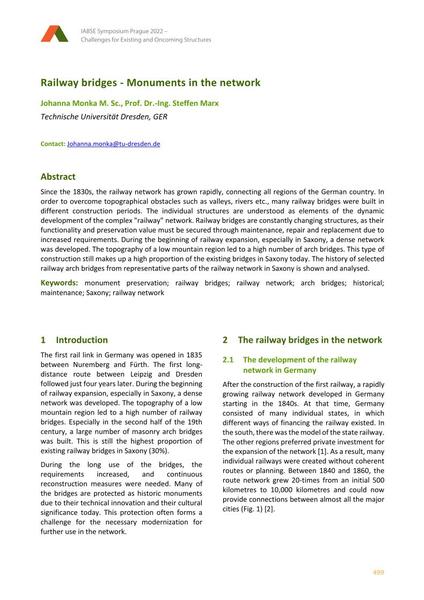Railway bridges - Monuments in the network

|
|
|||||||||||
Détails bibliographiques
| Auteur(s): |
Johanna Monka
(Technische Universität Dresden, GER)
Steffen Marx (Technische Universität Dresden, GER) |
||||
|---|---|---|---|---|---|
| Médium: | papier de conférence | ||||
| Langue(s): | anglais | ||||
| Conférence: | IABSE Symposium: Challenges for Existing and Oncoming Structures, Prague, Czech Republic, 25-27 May 2022 | ||||
| Publié dans: | IABSE Symposium Prague 2022 | ||||
|
|||||
| Page(s): | 499-506 | ||||
| Nombre total de pages (du PDF): | 8 | ||||
| DOI: | 10.2749/prague.2022.0499 | ||||
| Abstrait: |
Since the 1830s, the railway network has grown rapidly, connecting all regions of the German country. In order to overcome topographical obstacles such as valleys, rivers etc., many railway bridges were built in different construction periods. The individual structures are understood as elements of the dynamic development of the complex "railway" network. Railway bridges are constantly changing structures, as their functionality and preservation value must be secured through maintenance, repair and replacement due to increased requirements. During the beginning of railway expansion, especially in Saxony, a dense network was developed. The topography of a low mountain region led to a high number of arch bridges. This type of construction still makes up a high proportion of the existing bridges in Saxony today. The history of selected railway arch bridges from representative parts of the railway network in Saxony is shown and analysed. |
||||
| Mots-clé: |
ponts en arc
|
||||
| Copyright: | © 2022 International Association for Bridge and Structural Engineering (IABSE) | ||||
| License: | Cette oeuvre ne peut être utilisée sans la permission de l'auteur ou détenteur des droits. |
||||

